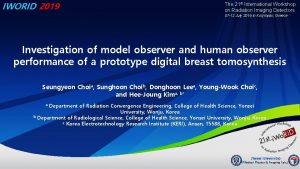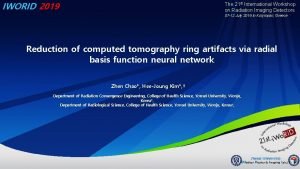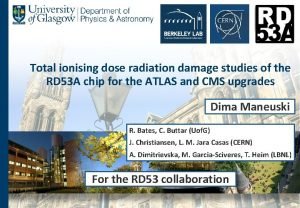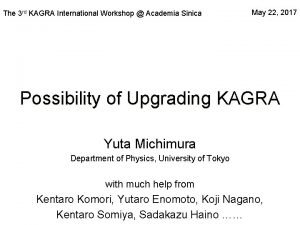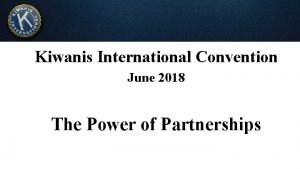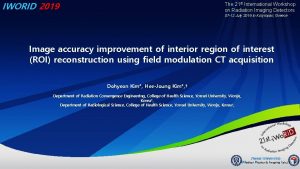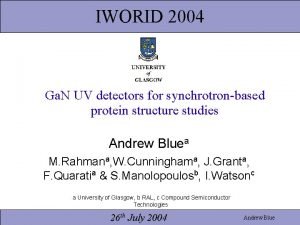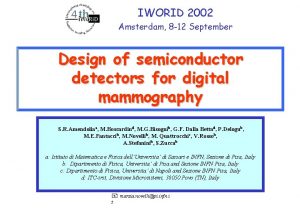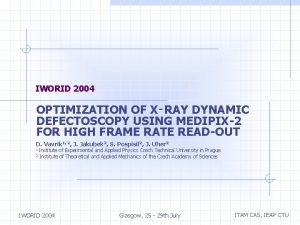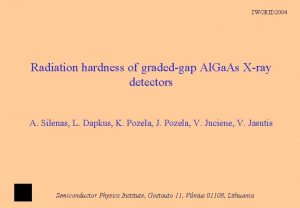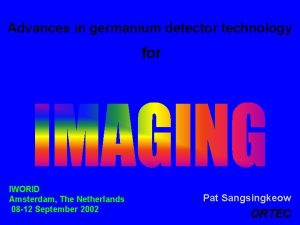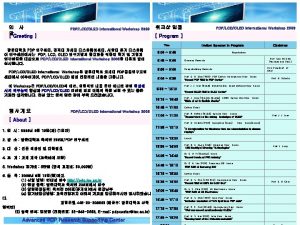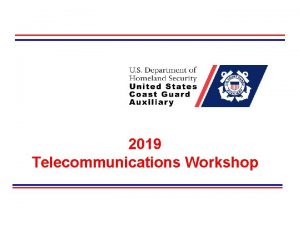IWORID 2019 The 21 st International Workshop on

























- Slides: 25

IWORID 2019 The 21 st International Workshop on Radiation Imaging Detectors 07 -12 July 2019 in Kolympari, Greece Reduction of computed tomography ring artifacts via radial basis function neural network Zhen Chao*, Hee-Joung Kim*, † Department of Radiation Convergence Engineering, College of Health Science, Yonsei University, Wonju, Korea*, Department of Radiological Science, College of Health Science, Yonsei University, Wonju, Korea†, (Yonsei University) (Medical Physics & Imaging Lab. )

Introduction IWORID 2019 1. 1. Causes of CT ring artifacts § Hardware-based factor a mis-calibrated or defective detector element, which results in rings centered on the center of rotation. ring artifacts Schematic picture showing how ring artifact is produced 1

Introduction IWORID 2019 1. 1. Causes of CT ring artifacts § Parameter-based factor § Physics-based factor ring artifacts (normal X-ray) (weak X-ray) Ring artifacts occur when a weak X-ray (low dose) or improper pitch is used § Boas et al. , Imaging in Medicine, 2012 2

Introduction IWORID 2019 1. 2. Adverse effects of CT ring artifacts Image aspect Clinical aspect § Destruction of effective Information § Interfering diagnosis effect § Reduction of image quality § Increasing cost Therefore, removing the ring artifacts and keeping the image resolution is hot topic (normal) (ring artifacts) Ring artifacts destroy valid information § Boas et al. , Imaging in Medicine, 2012 3

Introduction IWORID 2019 1. 3. Approaches of artifacts removal Category Features algorithms § Pre-processing limitation § Restricting the applicability § Large difficulty (sinogram-domain) algorithms § post-processing § Reducing image resolution (polar coordinate-domain) By comprehensive consideration, our research focuses on post-processing. § Liang et al. , Physics in Medicine & Biology, 2017 § Wang et al. , Neural Computing and Applications, 2019 4

Introduction IWORID 2019 1. 4. Previous works for solving the problems Problem list Previous solutions § Low image resolution 1) Artifact extraction and image subtraction 2) The application of interpolation technology § Normal information loss and artifact residues 1) The application of total variation-based method 2) Increasing the targeting of artifacts 3) The application of deep learning Limitations of previous studies - Difficult to extract artifact-only - Difficult to choose parameter - Difficult to make stopping criteria - Huge training data Therefore, The problems of extracting artifacts on the whole have not been solved § § Yan et al. , Physics in Medicine & Biology, 2016 Huo et al. , Electronics Letter, 2016 Liang et al. , Physics in Medicine & Biology, 2017 Wang et al Neural Computing and Applications, 2019 5

Introduction IWORID 2019 1. 5. Research direction statement ‘point-to-point’ and ‘pixel-to-pixel’ instead of ‘on the whole’ § It is based on: - Finding the exact positions of all artifacts by two smoothers and image subtraction. - Analyzing and processing each artifacts pixels by radial basis function neural network (RBFNN). 6

Materials & Methods IWORID 2019 2. 1. Polar coordinate transformation § in Cartesian coordinates , suppose M as (x, y) § in Polar coordinates, suppose M as (ρ, θ) Cartesian coordinates (x, y) to Polar coordinates (ρ, θ) to Cartesian coordinates (x, y) In order not to lose spatial resolution, we adopted nearest interpolation § Yan et al. , Physics in Medicine & Biology, 2016 8

Materials & Methods IWORID 2019 2. 2. Finding the positions of line artifacts § Applying the relative total variation (RTV): Ø ε: a small positive number Ø λ: smoothing weight § Liang et al. , Physics in Medicine & Biology, 2017 9

Materials & Methods IWORID 2019 2. 2. Finding the positions of line artifacts § Image subtraction: Ø Subtracting the image obtained by RTV from the original line artifacts image. § Further smoothing the obtained image: Lateral smoothing template A, the value of w is 30 -100 Finding line artifacts by increasing artifact recognition 10

Materials & Methods IWORID 2019 2. 3. Radial basis function neural network (RBFNN) § Connections between two neurons in input layer and hidden layer: ü i represent ith neuron in input layer ü p represent pth neuron in hidden layer § The expression of neurons in hidden layer: § Connections between two neurons in hidden layer and output layer: 11

Materials & Methods IWORID 2019 2. 3. Proposed RBFNN § Selection of neurons in input layer (What we need to do) Proposed RBFNN Two aspects are considered: 1. The effect of pending pixel itself 2. The effect of the surrounding normal pixels on artifact pixel 12

Materials & Methods IWORID 2019 2. 3. Proposed RBFNN § Selection of neurons in input layer Pixel value Gradient direction The sum of difference set The mean of difference set The variance of difference set The sum of weight set The mean of weight set The variance of weight set input variables (eight neurons ) (8 normal pixel values and artifact pixel value) (Difference values between The average of normal pixels and artifact pixel) difference (Weight values of normal pixels by inverse distance weighting (IDW) ) 13

Materials & Methods IWORID 2019 2. 3. Proposed RBFNN § Selection of neurons in hidden layer q It depends to a great extent on the training data selected. q The larger the number is, the better the effect is. q However the time consumption and generalization also need to be considered. Herein, we chose 40 as the number of neurons in the hidden layer. § Qasem et al Knowledge-Based Systems, 2012 § Aljarah et al Neural Computing and Applications, 2018 Proposed RBFNN 14

Materials & Methods IWORID 2019 2. 4. Training of proposed RBFNN According to the structure of our NN: Training algorithm Updated We proposed the hybrid of gradient descent method (GDM) and gravitational searching algorithm (GSA) for training. 15

Materials & Methods IWORID 2019 2. 4. Training of proposed RBFNN § Gravitational searching algorithm (GSA) The most suitable orbit Earth Base on this: § We regard as planet (object) (Solar System) § Rashedi et al. , Information sciences, 2009 § GSA is to find the most suitable orbit (position) of an planet (object) by Newton's law. 16

Results & Discussions IWORID 2019 2. 4. Training of proposed RBFNN § Gravitational searching algorithm (GSA) Generate initial arrays Acceleration calculation Acceleration Calculation Obtained by gradient descent method (GDM) Gravitation calculation i = 1, 2, . . . , 50 Mass calculation Stop if t =50 Position and velocity update Fitness function: B: the ideal output A: the actual output § Rashedi et al. , Information sciences, 2009 Stop or Back? By fitness function, find the optimal array 17

Materials & Methods IWORID 2019 2. 5. Experimental data § Training data and test data § Further explanation for training Mo (normal images) ve (simulated artifact images) (Original NN) 1 2 3 4 5 6 7 8 (brain data) (Chest data) q training data: 300 images q Training data: 160 images q Test data: 40 images (simulated q Test data: 80 images (real artifacts) Size: 512× 512 (8 input neurons ) So, Training pixels what we need, no whole (actual output values) (ideal output values) 18

Materials & Methods IWORID 2019 2. 6. Quantitative evaluation Image quality and distortion evaluation (Peak signal-to-noise ratio (PSNR)) ü m, n: the size of X, Y ü X: reference image ü Y: corrected image Similarity evaluation with reference images (Structural similarity (SSIM)) ü µx, µy: the mean values of images X, Y ü σx, σy : the standard deviations of images X, Y ü σxy : the covariance of images X, Y v Unidirectional total variation (UTV) method and Relative total variation-iterative (RTVI) method were implemented for comparison. § Huo et al. , Electronics Letter, 2016 § Liang et al. , Physics in Medicine & Biology, 2017 19

Results & Discussions IWORID 2019 3. 1. Brain data Original image with ring artifacts UTV (artifact residue) RTVI Proposed (artifact residue) 20

Results & Discussions IWORID 2019 UTV RTVI The SSIM of 40 brain data SSIM value PSNR value 3. 2. The performances of PSNR and SSIM values The PSNR of 40 brain data Proposed UTV 40 data RTVI Proposed 40 data v For all 40 CT brain data, The PSNR and SSIM performances of proposed method outperform those of other two methods. 21

Results & Discussions IWORID 2019 3. 3. Chest data Original image with real ring artifacts UTV RTVI Proposed 22

Results & Discussions IWORID 2019 Ring artifacts image Pixel value 3. 3. The performances of pixel profiles Artifacts RTVI UTV Proposed Pixel number 23

Conclusion IWORID 2019 q In this study, a proposed method which is based on the radial basis function neural network (RBFNN) for removing CT ring artifacts. ü New style: the point-to-point and pixel-to-pixel processing style, which increases the practicability of the method and enables it to act on all kind of cases. ü New construction: Although RBF neural networks are not new, the whole construction, mainly the selection of input neurons, is new. Moreover, we successfully applied it to ring artifact removal. ü New training method: the hybrid of gradient descent method (GDM) and gravitational searching algorithm (GSA). q By comparing with the other two recent methods, based on complicated data, it proves that our method has strong practicability and effectiveness. 24

Medical Physics & Imaging Laboratory Thanks for your attention Presenter’s e-mail address : chaozhen 1000@yonsei. ac. kr
 Iworid 2021
Iworid 2021 Iworid
Iworid Iworid 2019
Iworid 2019 Kagra international workshop
Kagra international workshop Kiwanis international convention 2019
Kiwanis international convention 2019 China international import export 2019
China international import export 2019 Thế nào là hệ số cao nhất
Thế nào là hệ số cao nhất Diễn thế sinh thái là
Diễn thế sinh thái là Vẽ hình chiếu vuông góc của vật thể sau
Vẽ hình chiếu vuông góc của vật thể sau Phép trừ bù
Phép trừ bù Lời thề hippocrates
Lời thề hippocrates Tư thế worm breton
Tư thế worm breton đại từ thay thế
đại từ thay thế Quá trình desamine hóa có thể tạo ra
Quá trình desamine hóa có thể tạo ra Công của trọng lực
Công của trọng lực Thế nào là mạng điện lắp đặt kiểu nổi
Thế nào là mạng điện lắp đặt kiểu nổi Khi nào hổ con có thể sống độc lập
Khi nào hổ con có thể sống độc lập Các loại đột biến cấu trúc nhiễm sắc thể
Các loại đột biến cấu trúc nhiễm sắc thể Vẽ hình chiếu đứng bằng cạnh của vật thể
Vẽ hình chiếu đứng bằng cạnh của vật thể Nguyên nhân của sự mỏi cơ sinh 8
Nguyên nhân của sự mỏi cơ sinh 8 Bổ thể
Bổ thể Phản ứng thế ankan
Phản ứng thế ankan Thiếu nhi thế giới liên hoan
Thiếu nhi thế giới liên hoan Chúa yêu trần thế alleluia
Chúa yêu trần thế alleluia điện thế nghỉ
điện thế nghỉ
